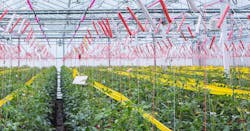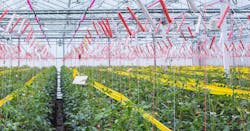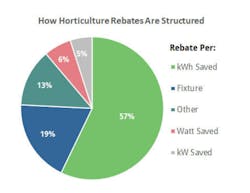How to Get the Best Rebates for Horticultural Lighting
It seems almost comical that humans have spent hundreds of years trying to find a replacement for a seemingly endless resource: the sun. But humankind is not often happy with the status quo; they want things bigger, faster, and better. For example, they want to grow plants in places that aren't typically hospitable to them, so they turned to electric lighting to grow plants indoors or supplement available sunlight.
Artificial light has always been expensive; the average energy cost made it unprofitable to use plant lights or horticulture lights in many applications. However, the technology has evolved over the years. Today, horticulture lighting can be found in many different applications, including greenhouses, vertical farms, and tobacco production, along with growing flowers, cannabis, and even components to make plant-based vaccines. It's a vast market that is growing rapidly due to technological and societal changes.
BriteSwitch, a firm specializing in capturing local, utility, state, and federal rebates/incentives for business, explains advancements in horticultural lighting and how to take advantage of rebates in this market.
LED advancements create new opportunities
Like they did with traditional lighting, LEDs came along and revolutionized grow lights. With 20% to 40% less energy usage than conventional HID grow lights, they provided a huge opportunity to cut operating costs for growers. The reduced wattage also meant less waste heat, which was hugely beneficial to indoor growing operations.
Not only were these LED horticulture lights cheaper to run, but they also provided an opportunity to increase the production and quality of the product. When growing plants indoors, the color of the light is important. The sun offers full-spectrum lighting (all wavelengths). As humans, we perceive these different wavelengths as colors (e.g., a 400-nm wavelength looks violet to us, while 700 nm looks red). Plants, on the other hand, interpret the wavelengths in a completely different way. The wavelengths can stimulate different processes in the plant. For example, red light triggers germination and stem growth, while blue can promote root development and transition to flowering. By fine-tuning which wavelengths hit the plant, its development and production can be optimized.
DLC Horticulture List helps weed out underperforming luminaires
In October 2019, the DesignLights Consortium (DLC) created a new standard and qualified product list (QPL), specifically for horticulture lighting. Over the years, the DLC has been the de facto standard that utilities use to ensure customers install high-quality lighting when applying for incentives. The DLC worked closely with manufacturers on the technical specifications for this list, considering the unique aspects of this type of lighting.
Since its debut, the DLC Horticulture List has grown rapidly. In September 2020, there were only 125 products on the list. Just a little over a year later, there are now more than 500 eligible luminaires.
Having a new category specifically for horticulture lighting gave rebate programs more confidence to provide incentives for these types of lighting. As a result, the number of rebates has increased substantially since the list's inception.
Rebates and horticulture lighting
LED horticultural lighting has a huge potential for energy savings. According to a U.S. Department of Energy report, if all horticulture lighting installations switched to LED, they could reduce the sector's annual energy consumption by 40%, resulting in cost savings of roughly $240 million. This opportunity makes it the perfect segment for commercial rebate programs to target with energy efficiency incentives.
Horticulture rebates were off to a relatively slow start, but with the introduction of the DLC Horticulture QPL and the evolution of the technology, they have grown. In fact, the number of utilities offering rebates for LED horticulture lighting has nearly tripled since 2020.
Different horticultural rebate approaches
About two-thirds of the rebates for horticulture lighting are custom rebates or based on energy savings. That's a big difference from traditional LED luminaires, where most rebates are prescriptive, or a set dollar amount per luminaire. As real-world data comes in and utilities fully understand the new technology, programs are expected to transition to easier-to-understand prescriptive incentives.
Horticulture rebate amounts
How much of a rebate a horticulture lighting project will see varies a lot based on the geographical area. The average custom rebate is about $0.13 per kilowatt-hour saved, but it's quite a large range from $0.02 to $0.40.
For prescriptive rebates, the average incentive is $130 per luminaire, although that can range from $10 to $325 depending on the specific luminaire type and area.
New construction projects can qualify as well
A substantial amount of horticulture lights is also being installed in new construction projects. They present a challenge for the rebate programs because, unlike retrofit projects, they don't have a baseline energy usage for savings calculations. Most new construction rebate programs for general illumination are based on energy savings compared to the local electrical code's lighting power density (LPD). For horticulture lighting, this really doesn't apply. These lights aren't being used for general illumination, so the typical watts per square foot analysis is essentially meaningless. Because of this, each program may calculate the rebate a little differently.
How to get rebates for horticultural lighting
With more than 150 horticulture lighting rebate programs available in North America, there's a good chance most projects would qualify for an incentive. Here are some tips to make sure you can get rebates for your horticulture lighting project.
- Use DLC horticulture-listed products. Most rebate programs require that the LED is on the DLC list to get a rebate. It's not enough that the spec sheet or website has a DLC logo; the specific model you're using must be on the current DLC website. When searching the site, make sure to select "Horticulture Lighting" as the QPL list; these fixtures don't appear on the more commonly used general lighting list.
- Make sure to get a rebate pre-approval. For many rebate programs, pre-approval is an essential part of the process that many people forget to consider. It usually takes about three to four weeks to get pre-approval, although it can take as long as eight to 10 weeks in some areas. Make sure you know the pre-approval requirements, and follow the steps of your local program. In some cases, a project must be pre-approved before even a PO is signed.
- Check program funding levels. Programs can run out of funding or change incentive levels at a moment's notice. While some utilities have funding meters on their website, a majority do not — and the only way to know for sure is to call them. This step is especially important for large projects because rebate programs often have limited funds; a large horticulture project can wipe out a smaller rebate program entirely.
- Verify the specific application is allowed. Not all horticulture applications are eligible for rebates. Due to conflicting state and federal regulations, some programs explicitly deny rebates for cannabis-related horticulture lighting. Also, the project needs to have a commercial account with the electric company; residential horticulture lighting rebates are virtually non-existent.
Randy Young is the operations manager at BriteSwitch, a company that specializes in finding and capturing rebates for businesses. He can be reached at [email protected].
About the Author
Randy Young
Director of Marketing and Data Solutions
Randy Young is the director of marketing and data solutions at BriteSwitch, a company that specializes in finding and capturing rebates for businesses. He can be reached at [email protected].


